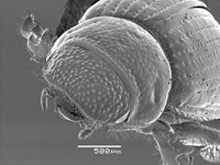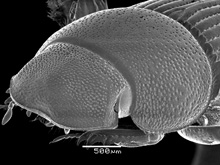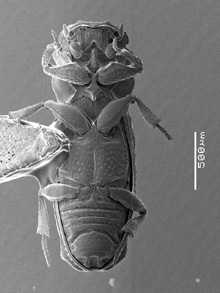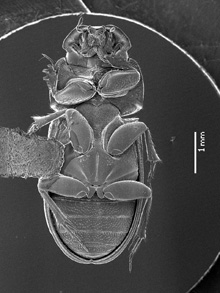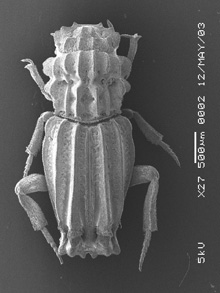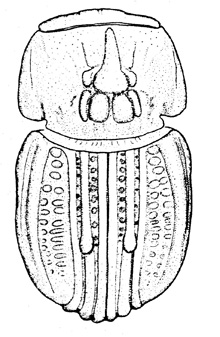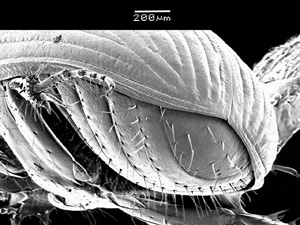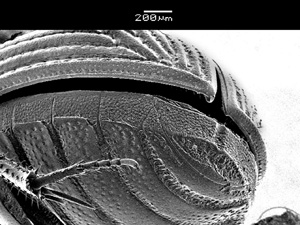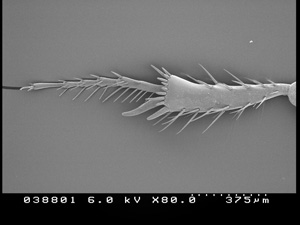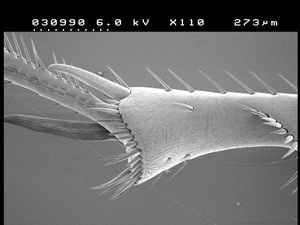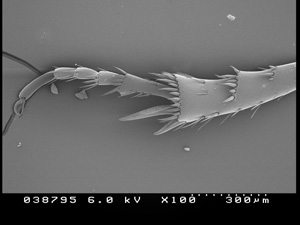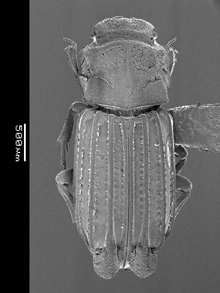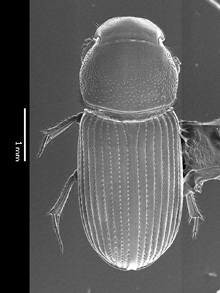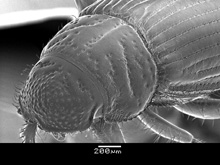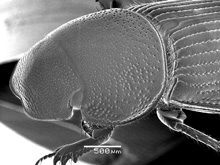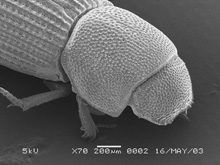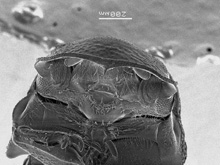| 1. |
Head with labrum and mandibles clearly visible in anterior view (Fig. 1) | |||||
1'. |
Head with labrum and mandibles hidden under clypeus (Fig. 2) | |||||
|
||||||
| 2(1). . |
Pronotum evenly convex (Fig. 3). Elytral intervals all equally convex | Tribe Aegialiini |
2'. |
Pronotum with distinct ridges and grooves (Fig. 4). Alternating elytral intervals carinate (Tribe Eupariini) | |
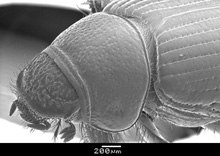 |
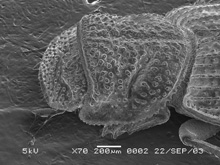 |
Figure 3. Aegialia argentina |
Figure 4. Annegialia ataeniformis |
| 3(1). . |
Head distinctly rugose and setose (Fig. 5). Argentina (Tribe Aegialiini) | |
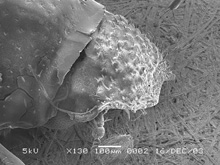 Figure 5. Argeremazus neuquen |
||
| 3'. . |
Head surface lacking distinct setae, or not from southern South America | . 4 |
| 4(3). . . |
Prosternal process projecting, hastate or stellate (Fig. 6). Meso- and metatibiae apparently lacking apical spurs. Pronotum and elytra deeply longitudinally ridged or grooved | |||||
4'. |
Prosternal process not projecting, not hastate nor stellate (Fig. 7). Meso- and metatibiae with distinct apical spurs. Pronotum and elytra rarely longitudinally ridged or grooved (pronotum often transversely ridged) | |||||
|
||||||
| 5(4). . . |
Apex of elytra with large tuberculate prominences (Fig. 8), bearing trichomes. Pronotum appearing constricted at middle, with a transverse groove or row of deep pits | Tribe Rhypariini KEY |
||||
5'. |
Apex of elytra lacking large tuberculate prominences (Fig. 9). Pronotum not transversely constricted at middle (Tribe Stereomerini) | |||||
|
||||||
| 6(4). . . .. . |
Elytral base lacking marginal bead. Elytral fold disappearing well before apex (Fig. 10). Pygidium entirely flat, unmodified by grooves or ridges. Femora never grooved on apical or posterior margins. Apical metatibial spurs usually separated by articulation of basal tarsal segment | |||||
6'. |
Elytral base with marginal bead. Elytral fold often attaining suture at apex, often thickened (Fig. 11). Pygidium modified with basal longitudinal groove that receives the elytra at rest, pygidium often with central transverse ridge and apical eroded area. Femora often with grooved margins. Apical metatibial spurs never separated by articulation of basal tarsal segment, spurs closely set at base and medial of tarsal articulation | |||||
|
||||||
| 7(6). . . |
Apical metatibial spurs contiguous at base and medial of tarsal insertion (Fig. 12), which does not articulate between the spurs. Some abdominal sternites fused | |||||
7'. |
Apical metatibial spurs more separated, closer to insertion of basal tarsal segment (Fig. 13), which articulates between the spurs. Abdominal sternites mostly freely movable | Tribe Aphodiini KEY |
||||
|
||||||
| 8(7). . . |
Transverse carina on outer face of metatibia reduced, can be obsolete (Fig. 12). Body weakly convex, color pale yellow (Tribe Didactyliini) | |||||
8'. |
Transverse carina on outer face of metatibia distinct, strong (Fig. 14). Body strongly convex, color black (Tribe Proctophanini) | |||||
|
||||||
| 9(6). . . |
Apex of elytra with large bulbous process (Fig. 15) (Tribe Eupariini) . |
|||||
9'. |
Apex of elytra normal, lacking unusual processes (Fig. 16) | |||||
|
||||||
| 10(9). . . . . |
Pronotum usually with transverse furrows separated by swellings (Fig. 17), furrows sometimes weak with only traces of impressions remaining, at least visible near eyes. Clypeus always granulate. Basal metatarsomere often shortened | |||||
10'. |
Pronotum without transverse swellings, sometimes with weak transverse impressions or medial longitudinal depression (Fig. 18). Clypeus rarely granulate. Basal metatarsomere rarely shortened | |||||
|
||||||
11(10). . |
Pronotum not tumid (swollen), often flattened; moderately declivous laterally, lateral margin visible from above; lateral margin near base rarely eroded and toothed. Anterior clypeal margin rarely broadened and flattened laterally, often flattened medially; edge usually sharp or bluntly rounded laterally. Protibial teeth usually evenly spaced along margin | |||||
11'. |
Pronotum robust, somewhat tumid anteriorly; sharply declivous laterally (Fig. 19), lateral margin usually not visible from above; lateral margin of pronotum usually eroded and often dentate near base. Anterior clypeal margin usually broad, flattened in front (Fig. 20) (most genera have a double edged clypeal margin). Protibial teeth often positioned more apically | |||||
|
||||||
